高中英语倒装句知识点讲义
- 格式:doc
- 大小:35.50 KB
- 文档页数:3
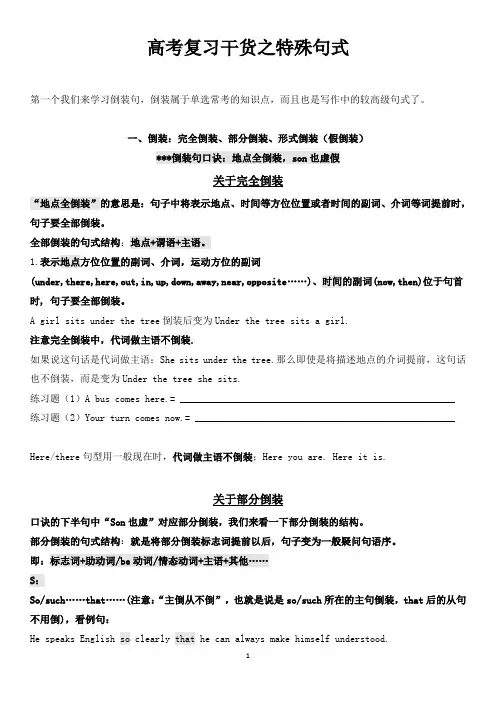
第一个我们来学习倒装句,倒装属于单选常考的知识点,而且也是写作中的较高级句式了。
一、倒装:完全倒装、部分倒装、形式倒装(假倒装)***倒装句口诀:地点全倒装,son也虚假关于完全倒装“地点全倒装”的意思是:句子中将表示地点、时间等方位位置或者时间的副词、介词等词提前时,句子要全部倒装。
全部倒装的句式结构:地点+谓语+主语。
1.表示地点方位位置的副词、介词,运动方位的副词(under,there,here,out,in,up,down,away,near,opposite……)、时间的副词(now,then)位于句首时, 句子要全部倒装。
A girl sits under the tree倒装后变为Under the tree sits a girl.注意完全倒装中,代词做主语不倒装.如果说这句话是代词做主语:She sits under the tree.那么即使是将描述地点的介词提前,这句话也不倒装,而是变为Under the tree she sits.练习题(1)A bus comes here.= _______________________________________________________ 练习题(2)Your turn comes now.= ____________________________________________________Here/there句型用一般现在时,代词做主语不倒装;Here you are. Here it is.关于部分倒装口诀的下半句中“S on也虚”对应部分倒装,我们来看一下部分倒装的结构。
部分倒装的句式结构:就是将部分倒装标志词提前以后,句子变为一般疑问句语序。
即:标志词+助动词/be动词/情态动词+主语+其他……S:So/such……that……(注意:“主倒从不倒”,也就是说是so/such所在的主句倒装,that后的从句不用倒),看例句:He speaks English so clearly that he can always make himself understood.=so是标志词,所以so clearly这个意群提前(举个例子来说意群:一辆出租车来了=来了一辆出租车,其中“一辆出租车”这几个字不能拆分,它就是一个意群),然后再将主句调整为上边说的部分倒装句式结构。
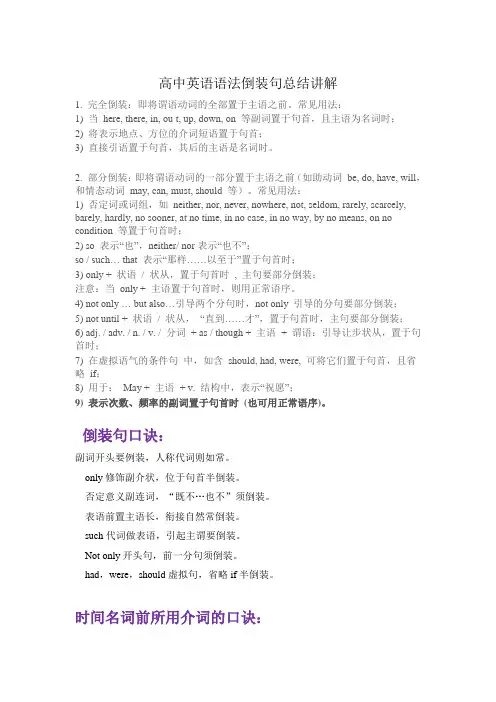
高中英语语法倒装句总结讲解1. 完全倒装:即将谓语动词的全部置于主语之前。
常见用法:1) 当here, there, in, ou t, up, down, on 等副词置于句首,且主语为名词时;2) 将表示地点、方位的介词短语置于句首;3) 直接引语置于句首,其后的主语是名词时。
2. 部分倒装:即将谓语动词的一部分置于主语之前(如助动词be, do, have, will,和情态动词may, can, must, should 等)。
常见用法:1) 否定词或词组,如neither, nor, never, nowhere, not, seldom, rarely, scarcely, barely, hardly, no sooner, at no time, in no case, in no way, by no means, on no condition 等置于句首时;2) so 表示“也”,neither/ nor表示“也不”;so / such… that 表示“那样……以至于”置于句首时;3) only + 状语/ 状从,置于句首时, 主句要部分倒装;注意:当only + 主语置于句首时,则用正常语序。
4) not only … but also…引导两个分句时,not only 引导的分句要部分倒装;5) not until + 状语/ 状从,“直到……才”,置于句首时,主句要部分倒装;6) adj. / adv. / n. / v. / 分词+ as / though + 主语+ 谓语:引导让步状从,置于句首时;7) 在虚拟语气的条件句中,如含should, had, were, 可将它们置于句首,且省略if;8) 用于:May + 主语+ v. 结构中,表示“祝愿”;9) 表示次数、频率的副词置于句首时(也可用正常语序)。
倒装句口诀:副词开头要例装,人称代词则如常。
only修饰副介状,位于句首半倒装。
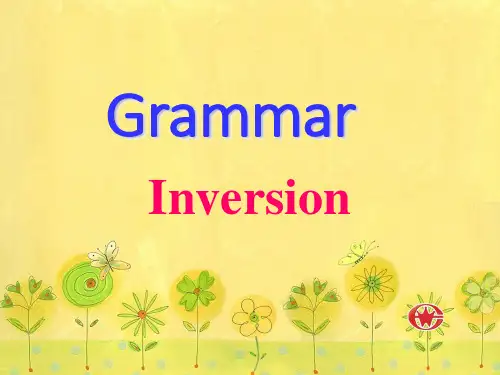
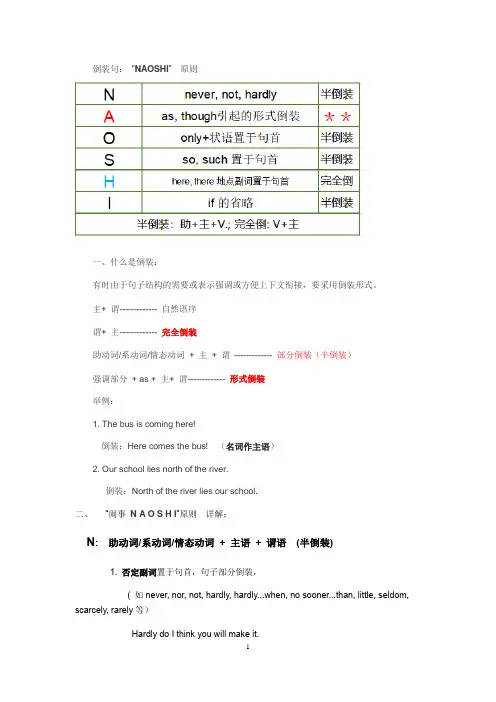
倒装句:“NAOSHI” 原则一、什么是倒装:有时由于句子结构的需要或表示强调或方便上下文衔接,要采用倒装形式。
主+ 谓------------- 自然语序谓+ 主------------- 完全倒装助动词/系动词/情态动词+ 主+ 谓------------- 部分倒装(半倒装)强调部分+ as + 主+ 谓------------- 形式倒装举例:1. The bus is coming here!倒装:Here comes the bus! (名词作主语)2. Our school lies north of the river.倒装:North of the river lies our school.二、“闹事N A O S H I”原则详解:N: 助动词/系动词/情态动词+ 主语+ 谓语(半倒装)1. 否定副词置于句首,句子部分倒装,( 如never, nor, not, hardly, hardly...when, no sooner...than, little, seldom, scarcely, rarely等)Hardly do I think you will make it.Not until midnight did it stop raining.Not only should we not be afraid of difficulties, but we should try our best to overcome them.2. 表示否定意义的短语置于句首,部分倒装,( 如at no time, under/in no circumstances, in no case, by no means,on no condition 等)By no means should you tell him about it. 你绝不要告诉他这事。
A : 形式倒装(前置)As/though引导的让步状语从句:只把强调的内容提到句首,主谓不用变化。
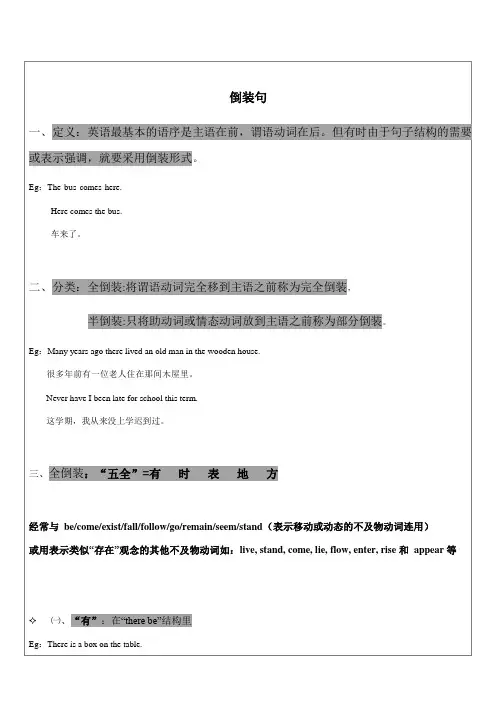
桌子上面有一个盒子。
✧㈡、“时”:表示时间副词,如:now,then,
Eg:Now comes your turn.
现在轮到你了。
✧㈢、“表”:表语放句子前,“表语+系动词+主语” 的结构
Eg:Present at the party were Mr. Green and many other guests.
格林先生和其他的客人在这个聚会上。
Seated on the ground are a group of young men.
一群年轻人坐在了地上。
✧㈣、“地”:地点状语放在句首
Eg:In south of the river lies a small factory.
小工厂位于河的南方。
From the valley came a cry.
山谷传来一阵哭声。
✧㈤、“方”:表方位的副词here, there 或out, in, up, down, away, off 等标志词放在句首 Eg:There lies a large wheat field in front of the house.
房子前面有一大片麦田。
Off all the lights went when I came in.
当我进来时,所有的灯都灭了。
四、半倒装:“八部”=不只让步也常需(虚)如此祝福✧㈠、“不”表示否定。
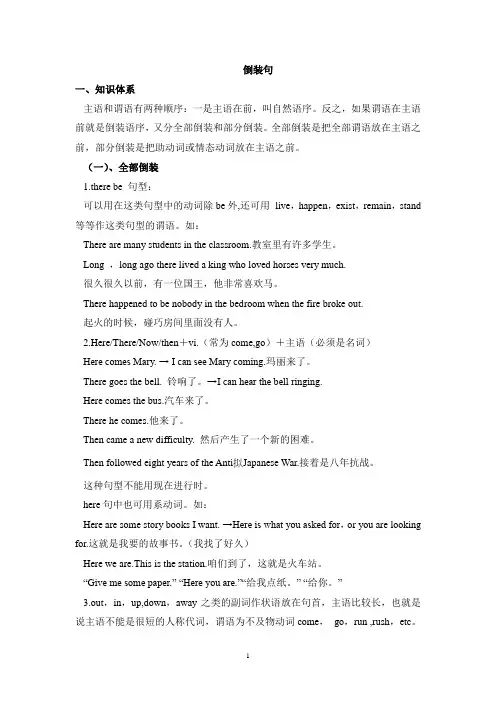
倒装句一、知识体系主语和谓语有两种顺序:一是主语在前,叫自然语序。
反之,如果谓语在主语前就是倒装语序,又分全部倒装和部分倒装。
全部倒装是把全部谓语放在主语之前,部分倒装是把助动词或情态动词放在主语之前。
(一)、全部倒装1.there be 句型:可以用在这类句型中的动词除be外,还可用live,happen,exist,remain,stand 等等作这类句型的谓语。
如:There are many students in the classroom.教室里有许多学生。
Long ,long ago there lived a king who loved horses very much.很久很久以前,有一位国王,他非常喜欢马。
There happened to be nobody in the bedroom when the fire broke out.起火的时候,碰巧房间里面没有人。
2.Here/There/Now/then+vi.(常为come,go)+主语(必须是名词)Here comes Mary. → I can see Mary coming.玛丽来了。
There goes the bell. 铃响了。
→I can hear the bell ringing.Here comes the bus.汽车来了。
There he comes.他来了。
Then came a new difficulty. 然后产生了一个新的困难。
Then followed eight years of the Anti Japanese War.接着是八年抗战。
这种句型不能用现在进行时。
here句中也可用系动词。
如:Here are some story books I wa nt. →Here is what you asked for,or you are looking for.这就是我要的故事书。
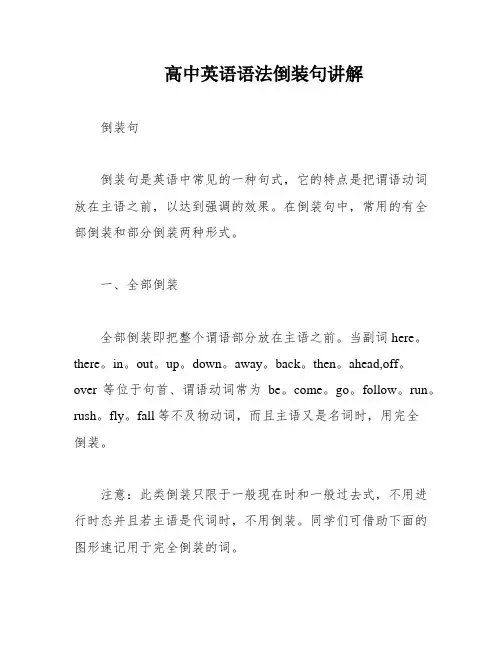
高中英语语法倒装句讲解倒装句倒装句是英语中常见的一种句式,它的特点是把谓语动词放在主语之前,以达到强调的效果。
在倒装句中,常用的有全部倒装和部分倒装两种形式。
一、全部倒装全部倒装即把整个谓语部分放在主语之前。
当副词here。
there。
in。
out。
up。
down。
away。
back。
then。
ahead,off。
over等位于句首、谓语动词常为be。
come。
go。
follow。
run。
rush。
fly。
fall等不及物动词,而且主语又是名词时,用完全倒装。
注意:此类倒装只限于一般现在时和一般过去式,不用进行时态并且若主语是代词时,不用倒装。
同学们可借助下面的图形速记用于完全倒装的词。
1.介词短语(地点状语)+不及物动词+主语A beautiful girl sits under the tree。
= Under the tree sits a beautiful girl。
树下坐着一位漂亮的女孩。
A big ___ of the lake。
= South of the ___的南边是一个大超市。
A modern swimming pool is located 20 miles east of our school。
= 20 miles east of our school ___。
我们学校向东20英里有一个现代化的游泳池。
Piles of old books。
magazines and newspapers are on the floor。
= On the floor were piles of old books。
magazines and newspapers。
地板上是一堆堆旧的书报杂志。
2.表方向、地点的副词(here。
there。
up。
down。
away)+不及物动词+主语,构成的全部倒装句___ ___ barking fiercely。
away fled the ___。
听到狗的狂叫声,小偷逃掉了。

Grammar of the Inversion (Module 5 Unit 4)倒装句英语最基本的语序是主语在前, 谓语动词在后。
但有时由于句子结构的需要或表示强调, 就要采用倒装形式。
倒装分两种情况: 1)将谓语动词完全移到主语之前称为完全倒装, 2)只将助动词或情态动词放到主语之前称为部分倒装。
并且强调性倒装和以so, neither, nor开头的句子是高考例题的热点。
一、倒装句的意义1.用倒装构成疑问句,适应一定的语法结构的需要。
.in?Was the People's Liberation Army founded in 1927?2.为了强调某一部分, 而把这部分放到句首, 构成倒装。
t.fo.schoo.thi.term.So early did he come to school that no other students came.二、倒装的用法完全倒装1.在“ther.be”结构里, there是引导词, 主语在be后。
在“there + be”结构中的谓语动词有时不用be , 而用表示类似“存在”观念的其他不及物动词。
如: live, stand, come, lie, flow, enter, rise 和appear等。
e.g.Ther.i..bo.o.th.table.There came shouts for help from the river.There lies a large wheat field in front of the house.Many years ago there lived an old man in the wooden house.2.为了表达生动, 有时把表地点、方位的副词, 如here, there, now , then,, thus ,up, down, out, off, over, away, in等放在句首, 同时把谓语动词放在主语之前, 在here, there等副词开头的某些句子里(要用一般现在时态)。
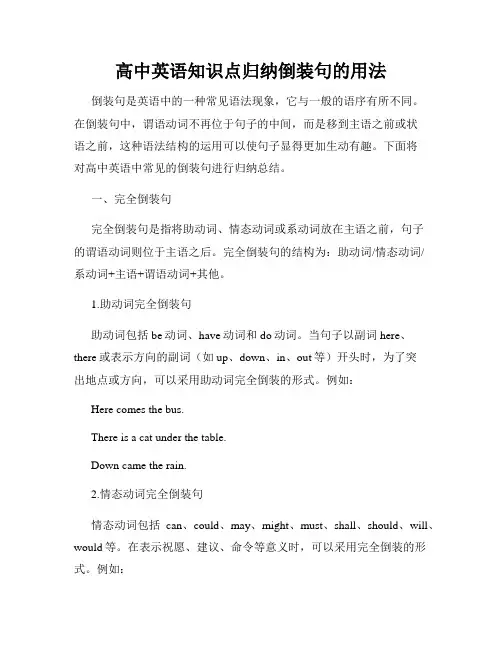
高中英语知识点归纳倒装句的用法倒装句是英语中的一种常见语法现象,它与一般的语序有所不同。
在倒装句中,谓语动词不再位于句子的中间,而是移到主语之前或状语之前,这种语法结构的运用可以使句子显得更加生动有趣。
下面将对高中英语中常见的倒装句进行归纳总结。
一、完全倒装句完全倒装句是指将助动词、情态动词或系动词放在主语之前,句子的谓语动词则位于主语之后。
完全倒装句的结构为:助动词/情态动词/系动词+主语+谓语动词+其他。
1.助动词完全倒装句助动词包括be动词、have动词和do动词。
当句子以副词here、there或表示方向的副词(如up、down、in、out等)开头时,为了突出地点或方向,可以采用助动词完全倒装的形式。
例如:Here comes the bus.There is a cat under the table.Down came the rain.2.情态动词完全倒装句情态动词包括can、could、may、might、must、shall、should、will、would等。
在表示祝愿、建议、命令等意义时,可以采用完全倒装的形式。
例如:May you have a happy birthday!Should you need any help, feel free to ask.Will you please close the door?3.系动词完全倒装句系动词包括be动词、seem、appear、look、sound等。
在表示位置、方式、状态、主语特征等方面时,可以采用系动词完全倒装的形式。
例如:On the table lies a book.How beautiful the flowers are!Tired as he was, he kept working.二、部分倒装句部分倒装句是指将谓语动词的一部分(通常是助动词或情态动词)与主语之间的位置对调,这种语法结构常见于否定句、选择疑问句和以感叹词开头的句子。

英语倒装句倒装有两种:一将主语和谓语完全颠倒过来,叫做完全倒装。
如:In came a man with a white beard.二只将助动词(包括情态动词)移至主语之前,叫做部分倒装。
如:Only once was John late to class.英语句子的倒装一是由于语法结构的需要而进行的倒装,二是由于修辞的需要而进行的倒装。
前一种情况,倒装是必须的,否则就会出现语法错误;后一种情况,倒装是选择性的,倒装与否只会产生表达效果上的差异。
一完全倒装的四种主要类型(有地钻状洞动)1. here 和there、now、then位于句首时的倒装表示地点的here和there位于句首时,其后用完全倒装形式。
这类倒装句的谓语通常是动词be和come, go等表示移动或动态的不及物动词:Here’s Tom. 汤姆在这里。
There’s Jim. 吉姆在那儿。
Here comes the bus. 公共汽车来了。
There goes the bell. 铃响了。
There goes the last train. 最后一班火车开走了。
【注意】(1)以上倒装句中的谓语动词come和go不能用进行时态,即不能说Here is coming the bus。
(2) 若主语为代词,则不倒装:Here I am. 我在这儿。
/ 我来了。
Here it comes. 它来了。
(3) 其中的动词有时也可能是stand, lie, live等表示状态的动词(表示存在):There stood a desk against the wall. 靠墙放着一张书桌。
Once upon a time there lived a man known by the name of Beef. 从前有个人名叫比夫。
2. away和down等位于句首时的倒装地点副词away, down, in, off, out, over, round, up 等位于句首时,其后用完全倒装语序。

高二英语必修五语法知识点:倒装句讲解高二英语必修五语法知识点第四讲、倒装句讲解。
倒装句是高考英语试卷中必定会考到的一个点,所以这个语法知识点不容忽视。
下面让为同学们详细的讲解关于倒装语句同时配有专项训练,看看你都能做对吗?1.倒装句的定义:英语中最基本的语序是主语先于谓语动词。
如果把谓语动词放在主语前面,就叫做倒装。
2.倒装句的构成a)完全倒装完全颠倒句子的主语和谓语被称为完全颠倒。
areyoufromhere?你是本地人吗?b)部分倒置只将助动词、系动词或情态动词移至主语之前,谓语的其他部分仍保留在主语的后面,称之为部分倒装。
例如:只有这样,我们才能做得更好。
只有这样我们才能把工作做得更好。
3.倒置的原因a)句子语法结构的需要。
例如:你参加会议了吗?你参加会议了吗?longlivepeace!和平万岁!b)某些句型的固定用法。
例如:suchwerehislastwords.他最后的话就是这样。
c)强调需要。
倒装句后,句子更加流畅生动。
例如:neverbeforehaveweseensuchasight.以前我们从来没有见过这样的情景。
在我们遇到困难之前。
我们面前有许多困难。
oftendidwewarnthemnottodoso.我们曾多次警告他们不要这样做。
4.倒装句的基本用法a)构成疑问句(除对主语或主语之定语提问的特殊疑问句外):我们什么时候去追求幸福?我们什么时候喝你的结婚酒?haveyouseenthefilm?你看了那部电影吗?b)在以副词开头的句子中,如here、there、now、then、In、away、updown等:awaywentthecrowdonebyone.人们一个一个地离去。
c)当副词+状语置于句首时:onlythendidherealizehismistakes.只有在那时他才认识到自己的错误。
只有这样,你才能学习数学。
只有这样你才能学好数学。
d)含有否定意义的副词或连词(如little,hardly,never,rarely,nosooner?than等)放在句首时:我没想到他还能活着回来。
高中英语倒装句讲解高中英语倒装句讲解一、什么是倒装句倒装句是英语中常用的一种语法结构,它通过改变句子中词语的正常顺序,使句子更加生动、形象。
在倒装句中,主语和宾语的位置常常颠倒,同时句子结尾的语态也不同于正常语序。
二、倒装句的种类1、完全倒装句:这种类型的倒装句把主语和宾语完全颠倒,让宾语出现在主语之前。
例如:“Here comes the bus”(公交车来了)。
2、部分倒装句:这种倒装句只把助动词、系动词或情态动词放在主语前面,其余部分仍保持正常语序。
例如:“Are you ready to leave?”(你准备好离开了吗?)三、如何使用倒装句1、为了让句子更加生动,可以使用倒装句。
例如,比起常规语序的“The book is on the table”,使用倒装句“On the table is the book”更能突出物体的位置。
2、在一些情况下,使用倒装句可以更好地表达对比、惊讶等感情色彩。
例如,“Out rushed the dog”比“The dog rushed out”更能表达出狗冲出来的急迫感。
3、在一些疑问句中,为了更好地表达疑问点,需要使用倒装句。
例如,“Did he go to school yesterday?”比“Did he go to school?”更加具体。
四、注意事项1、在使用倒装句时,要注意句子的逻辑性和连贯性,避免出现歧义或误解。
2、在写作中,要根据文章的整体风格和语境来选择使用倒装句,不要过度使用,以免影响阅读体验。
3、在学习倒装句时,要掌握不同类型的倒装句的语法规则,并通过大量的阅读和写作实践来提高自己的语感和应用能力。
总之,掌握英语倒装句对于提高英语表达能力和写作水平都非常重要。
通过深入理解倒装句的语法规则,正确运用倒装句,可以让我们的英语表达更加生动、丰富,更具有表现力和感染力。
高中英语倒装句讲解 Final approval draft on November 22, 2020倒装句讲解英语句子通常有两种语序:一种是陈述语序,一种是倒装语序。
将谓语的一部分或全部置于主语之前的语序叫做倒装语序。
倒装可分为二种:将整个谓语提到主语之前的叫完全倒装(full inversion);而只将be 、情态动词或者助动词放在主语之前的叫做部分倒装(partialinversion)。
形式倒装:只把强调的内容提至句首,主谓并不倒装形式倒装有四类:(1)感叹句:What + a/an + adj +n.+(主语+谓语)!How + adj /adv.+(主语+谓语)!(2)The+比较级+正常语序句子,The+比较级+正常语序句子。
“越……,越…….。
”(3)Whatever+n.+主语+谓语,主句。
However+ adj/adv+主语+谓语,主句。
(4)As/Although引导让步状语从句时,可以对表语、谓语、状语进行强调。
(注意:若对表语进行强调时,表语为单数可数名词,形容词最高级时,要省掉冠词)一、完全倒装1. There be结构。
另外,在此结构中可以用来代替be动词的动词有:exist, seem, happen, appear, live, rise, stand等。
如:There stood a dog before him.There exist different opinions on this question.巩固练习:1) ________ a beautiful palace ________ the foot of the hill.A. There stand; atB. There stands; underC. Stands there; underD. There stands; at2 (1).在以here、there、now、then等副词开头的句子里。
高中英语知识点归纳倒装句的用法及常见情况倒装句是英语语法中一个重要的句法结构,它在句子中有特殊的应用。
本文将归纳总结高中英语中关于倒装句的用法及常见情况,以帮助大家更好地理解和运用倒装句。
一、倒装句的基本用法倒装句是指把原本主语和谓语的次序颠倒,使谓语动词或助动词出现在主语之前的一种句法结构。
在英语中,倒装句主要有三种基本形式:全部倒装、部分倒装和助动词倒装。
1. 全部倒装全部倒装是指将整个谓语部分完全颠倒,即将谓语动词或助动词放在主语之前。
常见情况有:在以否定词开头的句子中,当否定副词not,never,hardly,scarcely,little等放在句首时;以及在表示地点、时间或方式的状语从句中。
例1:Not only does he speak English fluently, but he also speaks French.例2:Hardly had I arrived home when it started to rain.例3:In the garden were some beautiful flowers.2. 部分倒装部分倒装是指将助动词,或情态动词,或谓语动词的某些形式移到主语之前。
常见情况包括:带有否定意义的词或短语出现在句首时;含有表示条件的副词或介词短语的句子;以及为了强调某一部分内容。
例4:Never have I seen such a beautiful sunset.例5:Had I known the truth, I would not have told her.例6:Only in this way can we achieve success in our study.3. 助动词倒装助动词倒装是指将助动词提到主语之前,用于疑问句或以so/neither/nor开头的句子,其目的是避免重复。
例7:Do you know him? —— No, I don't.例8:She is reading a book, and so am I.例9:He doesn't like ice cream, and neither do I.二、倒装句的常见情况除了基本的倒装句形式外,倒装句还有一些常见的情况和特殊用法需要掌握。
⾼中英语倒装句讲解Module 3 LiteraturePeriod3 Grammar1 (3.26 2课时)⼀.学习内容1.学习倒装句,并能熟练运⽤。
⼆.学习⽅法提前预习课本,预习新语法点知识点。
语法:倒装句⼀、简介1.定义:英语句⼦的⾃然语序是主语在前,谓语动词在后。
有时为了语法结构的需要或是为了强调,若把谓语动词放在主语之前,主谓倒装,则构成倒装句。
2、分类:①完全倒装:如果全部谓语放在主语之前,叫完全倒装。
Eg.There is a book on the table.②部分倒装:如果只把助动词,情态动词或系动词放在主语之前就叫部分倒装。
eg. Only in this way can we learn English well.⼆、讲解1.完全倒装通常只⽤于⼀般现在时和⼀般过去时,且主语是名词①There be 句型:There be 句型中(be 还可以换成live,stand, lie, exist等表⽰状态的动词)要⽤完全倒装。
eg. There stands a tall tree on the top of the hill.②以here, there开头的句⼦⾥,谓语是come,go等不及物动词的单个形式时。
eg. There goes the bell.Here are the books.等⽅向性副词开头的句⼦,需完全倒装。
③副词out, in, up, down, off, away, below, back以及now, then,thus开头的句⼦⾥,谓语动词是come, go, be, run等不及物动词的单个形式时。
eg. Away hurried the boy.Now comes your turn.Up it flew.The door opened and in came our headmaster.④表地点的介词短语位于句⾸(如:in the room, on the wall等),谓语是be, stand, sit, lie等单个动词时,需完全倒装eg. In a lecture hall of a university in England sits a professor.Around the lake are some tall tree.At the end of the valley lies a small lake.Under the table sleeps a brown cat.⑤形容词、过去分词或介词短语作表语置于句⾸时,表语+系动词+主语(如:such),需完全倒装。
高三英语倒装句知识点倒装句是英语中的一种特殊语法结构,常见于状语、地点状语、时间状语等部分的倒装,它的使用可以使句子更加丰富多样,并起到强调的作用。
下面将介绍一些高三英语中常见的倒装句知识点。
一、完全倒装1. 当句子以否定词开头时,常出现完全倒装。
例子:Never have I seen such a beautiful sunset.解析:否定词"Never"位于句首,使得动词"have"与主语" I"发生倒装。
2. 当表示地点的短语或副词位于句首时,常出现完全倒装。
例子:In front of the house stood a tall tree.解析:地点短语"In front of the house"位于句首,使得动词"stood"与主语" a tall tree"发生倒装。
3. 当表示方向的副词放在句首时,常使用完全倒装。
例子:Down the street ran the little boy.解析:副词"Down"置于句首,使得动词"ran"与主语" the little boy"发生倒装。
二、部分倒装1. 当句子以表示否定的副词或短语开头时,常出现部分倒装。
例子:Not only did she pass the exam, but she also got the highest score.解析:否定副词"Not only"位于句首,使得助动词"did"与主语"she"发生倒装。
2. 当使用含有比较级的状语从句时,常出现部分倒装。
例子:The harder you work, the more progress you will make.解析:状语从句"the harder you work"中的主谓发生倒装。
高中英语倒装句讲义-学生版倒装句一、倒装句之全部倒装全部倒装是只将句子中的谓语动词全部置于主语之前。
此结构通常只用与一般现在时和一般过去时。
常见的结构有:1)here,there,now,then,thus等副词置于句首,谓语动词常用be,come,go,lie,run.There goes the bell.Then came the chairman.Here is your letter.2)表示运动方向的副词或地点状语置于句首,谓语表示运动的动词。
Out rushed a missile from under the bomber.Ahead sat an old woman.注意:上述全部倒装的句型结构的主语必须是名词,如果主语是人称代词则不能完全倒装。
例如:Here he comes.Away they went.二、倒装句之部分倒装部分倒装是指将谓语的一部分如助动词或情态倒装至主语之前。
如果句中的谓语没有助动词或情态动词,则需添加助动词do,does 或did,并将其置于主语之前。
1)句首为否定或半否定的词语,如no,not,never,seldom,little,hardly,at no time,in no way,等。
Never have I seen such a performance.Nowhere will you find the answer to this question.Not until the child fell asleep did the mother leave the room.当Not until引出主从复合句,主句倒装,从句不倒装。
注意:如否定词不在句首不倒装。
I have never seen such a performance.The mother didn‘t leave the room until the child fell asleep.典型例题1)Why can‘t I smoke here?At no time___in the meeting-roomA.is smoking permittedB.smoking is permittedC.smoking is it permittedD.does smoking permit以否定词开头作部分倒装需要注意的重点知识not only…but also,hardly/scarcely…when,no sooner…than not until…neither...nor...Not only did he refuse the gift,he also severely criticized the sender.Hardly had she gone out when a student came to visit her.No sooner had she gone out than a student came to visit her.Neither did I know,nor did I care what happened to him.Not until he returned did we know the truth.注意:只有当Not only…but also连接两个分句时,才在第一个分句用倒装结构。
倒装英语的正常语序是“主语 + 谓语”,即主语在前,谓语在后。
有时为了强调句子结构的需要,把谓语的一部分或全部放在主语之前,主语和谓语出现倒置形式。
倒装又可分为完全倒装和部分倒装。
将谓语动词完全移到主语之前的称为完全倒装,也叫全部倒装; 只将助动词、be动词或情态动词放到主语之前的称为部分倒装。
一、完全倒装1. 完全倒装是将谓语全部放在主语之前,此结构通常只用于一般现在时和一般过去时。
*Up went the rocket into the air.嗖地火箭就飞上天了。
*Inside the classroom are the students and the teacher.老师和学生在教室里。
等简短副词或above, away, in, out 等方位副词于句首,谓语动词常用be, come, go, lie, run等动词。
*Then came another question. 接着又一个问题提出来了。
*Look, here comes the taxi. 瞧,出租车过来了。
表示地点的介词短语(如on the wall, under the tree, in front of the house, in the middle of the room 等)放在句首时。
*Under a big tree sat a little boy. 一个小男孩坐在树下。
South of the lake lies a big supermarket. 湖的南边是一个大超市。
【注意】这种倒装中,主语必须是名词,主语是人称代词时,主语和谓语语序不变。
*In he came and the lesson began.他走进来开始上课。
铃一响,学生就冲出去了。
Hearing the bell ring, out rushed the students .Hearing the bell ring, out they rushed.(2)表语置于句首时,倒装结构为“表语+连系动词+主语”。
*Present at the meeting was Mr Green, a headmaster with his friends.校长格林先生和他的朋友们出席了会议。
Seated on the ground are a group of young people.坐在地上的是一群年轻(1) In front of the house stopped a police car.房子的前面停着一辆警车。
(2) Here is the letter you have been looking forward to.你盼望已久的信在这儿。
(3) Gone are the days when women were looked down upon.妇女受歧视的日子一去不复返了。
二、部分倒装1. 部分倒装是指将谓语的一部分,如助动词或情态动词,移至主语之前。
*Little did he know who the woman was.他不太知道那个女的是谁。
*Only in this way can you master English.只有这样你才能掌握英语。
2. 常见的部分倒装的结构。
(1)含有否定意义的否定词或半否定词包括短语(如never, neither, nor, little, seldom, rarely, hardly, scarcely, few, not, no, by no means, in no way, at no time等)放在句首时。
*Little did I dream of seeing such wonderful scenery.我做梦也没想到会看到这样美妙的景色。
*Never shall I do this silly thing again.我再不会做这种傻事了。
【注意】● 1.“Not only+分句,but also+分句”句型中的前一分句要部分倒装。
*Not only can he speak English, but he can also speak Japanese fluently.他不但会讲英语,而且还能流利地讲日语。
● 2. 表示“刚/一……就……”的倒装句型。
*Hardly had the game begun when it started raining.比赛刚刚开始就下起了雨来。
*No sooner had he arrived in Rome than he was kidnapped.他刚到罗马就遭到了绑架。
*Scarcely had I come in when the phone rang.我刚刚一进去,电话就响了。
● 3. Not until 句型直到我妈回来我才有手机上传作业。
I didn’t get the mobile phone to upload the assignment until my mother came back.It was not until my mother came back that I got the mobile phone to upload the assignment.Not until my mother came back did I get the mobile phone to upload the assignment.直到新冠消除我们才会上学。
Not until the coronavirus is wiped out will we go back to school.● 4. in no time 放在句首要倒装吗?(2)副词 only修饰状语置于句首时。
*Only then did he realize the importance of his family.只有在那时他才意识到家人的重要性。
*Only in this way can you solve this problem.只有用这种方法, 你才可以解决这个问题。
*Only when the war was over in 1918 was he able to get back to work. 直到1918年战争结束,他才能回去工作。
只有他能回答这个问题。
*Only he can answer the question.(3) as引导的让步状语从句(as可以换成though)。
a. 表语(形容词/名词)+ as+ 主语+ 系动词*Famous as he is, he is easygoing.尽管他很有名气,但他很平易近人。
*Child as/though he is, he knows a lot.尽管他是个孩子,但他懂得很多。
b. 副词+ as+主语+谓语动词*Hard as he tried, he couldn’t pass the exam.尽管他努力了,他还是没有通过考试。
c. 动词原形+as+ 主语+ might/may*Try as she may, she won’t pass it.尽管愿意再试,她还是不会通过的。
【注意】实义动词放在句首时,其他助动词放在主语后。
*Try as I might, I could not lift the stone.我用尽力气,可还是举不起这块石头。
(4)“so. . . that. . . ”和“such. . . that. . . ”结构中的so或such位于句首时。
*So fast does light travel that we can hardly imagine its speed.光运行得非常快,我们几乎无法想象它的速度。
*Such a lovely toy did he buy me that I was very thankful to him.他给我买了这么可爱的一个玩具,我非常感激他。
(5)在虚拟条件句中,从句的谓语含有were, had 和should这三个词时,可省去if,将这些词移至主语之前构成部分倒装。
如果我是你,我不会让这么好的一个机会溜走的。
*Were I you(=If I were you), I wouldn’t have such a good chance slip.如果明天下雨,我们就待在室内看书。
*Should it rain tomorrow(=If it should rain tomorrow), we would stay indoors reading books.要是你参加了毕业典礼,我就会见到你了。
*Had you attended(=If you had attended) the graduate ceremony, I should have seen you.(6)so作“也”讲时,引导的句子用倒装语序,表示前面所说的也适用于另一个人或事物,表示“……也(不)是如此”。
其句型是: so/neither/nor+be动词/助动词/情态动词+主语。
他能游泳。
我也能游泳。
*He can swim. So can I.昨天晚上他去看电影了。
我也去了。
*He went to the film last night. So did I.我不知道他住哪儿。
她也不知道。
*I don’t know where he lives. Neither does she.【注意】●①当so引出的句子是用以对上文内容的证实或肯定,表示“的确如此”时,不用倒装结构。
*—He works very hard. 他学习很努力。
—So he does and so do you. 他的确如此,你也是。
●②若表示一个人的两个或者两个以上的情况,也适用于另一个人,则用句型: So it is/was with sb. 或者It is/was the same with sb. 。
*—He was born in Shanghai and brought up in Beijing.他在上海出生,在北京长大。
—It was the same with my friend Li Ping.我朋友李平也是。
(7) to such a degree/ to such an extent/ to such lengths等介词短语位于句首时也要用倒装To such an extent had he changed that I couldn’t recognize him.他变得我简直认不出来了。
To such lengths did he speak that everyone got bored.他讲了很长时间,大家都厌倦了。